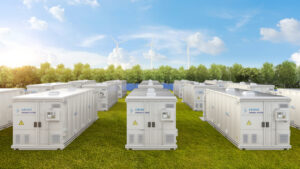ASX Renewable Energy Stocks: Woodside wants to recycle greenhouse gas emissions into ethanol

Woodside is collaborating with the Eastern Regional Council (EMRC) on a carbon-to-products pilot project. Pic: Jose A. Bernat Bacete via Getty Images
- Woodside pilot project would convert greenhouse gases into value-added ethanol
- Strike uses geothermal mapping to spot hot sedimentary aquifer geothermal resource potential
- Magnis results in for high performing anode materials using no chemical, acid or thermal purification
Woodside (ASX:WPL)
Woodside is collaborating with the Eastern Regional Council (EMRC) on a carbon-to-products pilot project aiming to recycle greenhouse gases into useful products.
The two parties have agreed on the terms of a proposed option to lease land, which will be used for a pilot Carbon Capture and Utilisation (CCU) facility, and for the supply of landfill gas by ERMC to Woodside.
This CCU facility would convert greenhouse gases, such as methane and carbon dioxide, into value-added ethanol, using technologies developed by US-based companies ReCarbon and LanzaTech.
The pilot aims to demonstrate that the integration of these technologies has the potential to contribute to decarbonisation and a circular carbon economy.
“This project has the potential to shift the dial on the future treatment of greenhouse gases as a resource, rather than a challenge,” EMRC CEO Marcus Geisler said.
“It will be these kinds of powerful collaborations and innovative decarbonisation initiatives that aim to deliver significant environmental and social benefits to Perth’s Eastern Region, Western Australia and the world.”
Following execution of the option to lease, exercise of the option to lease and construction of the CCU facility is subject to a final investment decision (FID) by Woodside targeted to occur in the second half of 2022.
A targeted completion and commissioning date has been earmarked for the second half of 2024.
Woodside CEO Meg O’Neill welcomed the collaboration with EMRC and the shared drive to explore the potential of CCU.
“Woodside believes CCU is an emerging field as customers seek lower-carbon solutions,” she said.
“Our climate strategy has two key elements: reducing our net equity Scope 1 and 2 greenhouse gas emissions, and investing in the products and services that our customers need as they too reduce their emissions.
“CCU has the potential to contribute to both elements of our climate strategy.”
Woodside (ASX:WPL) share price today
Strike Energy (ASX:STX)
Strike Energy has wrapped up the incorporation of its Perth Basin database into its Mid-West geothermal energy model, after an independent assessment by Monteverde Energy Consultants.
STK has used this geothermal inferred resource mapping to inform the areas of the best hot sedimentary aquifer geothermal resource potential, where gas is not present (and brines are), as well as the surface areas which have the highest likelihood of supporting a future commercial development.
This analysis has formed the basis of Strike’s application to the regulator for the conversion of its Geothermal Special Prospecting Authority (GSPA) area (3,513km²) to a Geothermal Exploration Permit (GEP) of 1,826km².
The GEP issuance as per its right under the GSPA remains pending at the date of this release.
STK managing director and CEO Stuart Nicholls said the booking of the certified inferred resource for the proposed zero-carbon Mid-West Geothermal Power Project is the first of a series of exciting milestones to come.
“This will facilitate the drill planning of Future State-1, which will be the first physical test of the region’s geothermal potential,” he said.
“Success at this project could provide Strike with 226 MWe of base load, 24/7, dispatchable zero carbon electricity to integrate into its planned and growing power consumption across its domestic gas and downstream fertiliser and ammonia facilities.”
This integration will also support Strike’s Net Zero 2030 target, Nicholls added, and drive down the associated carbon of its products thereby increasing their global competitiveness.
Strike Energy (ASX:STX) share price today
Magnis Energy Technologies (ASX:MNS)
Magnis has received the latest results for its high performing green anode materials using no chemical, acid or thermal purification and via mechanical processes only.
Electrochemical battery performance of Nachu coated spherical graphite (CSPG) battery anodes – from the company’s Nachu Project in Tanzania – using lithium-ion battery cells has produced a high yield (70%) CSPG product with a low carbon footprint, using greener and energy saving processing tech.
This means the company can now produce ultra-high purity (+99.95%) natural flake graphite feedstock from its Nachu Project without any chemical, acid and thermal purification, demonstrating an ‘excellent’ lifespan and readiness for the next step of commercialisation.
With the help of its technology partner, Charge CCCV (C4V) the electrochemical battery performance of Nachu CSPG anode has been extensively tested, validated and qualified using commercial graded lithium-ion battery cells.
These full cells have had over 1000 cycles while retaining at least 90% of initial cell capacity.
MNS chairman Frank Poullas said the company is blessed with such an amazing resource.
“Being able to produce a high quality, high performing green anode product at +99.95% purity or above without any acid, chemicals or thermal purification while using mechanical processes only, is truly remarkable.”
Magnis Energy Technologies (ASX:MNS) share price today
Related Topics
UNLOCK INSIGHTS
Discover the untold stories of emerging ASX stocks.
Daily news and expert analysis, it's free to subscribe.
By proceeding, you confirm you understand that we handle personal information in accordance with our Privacy Policy.








